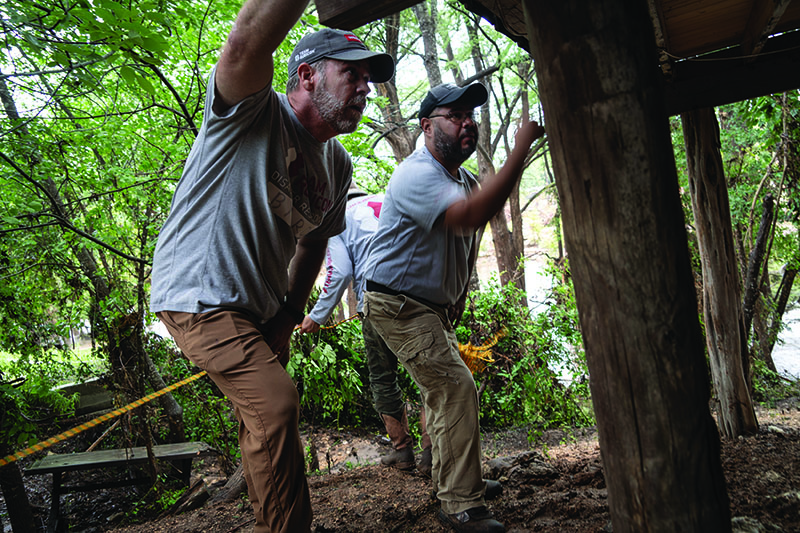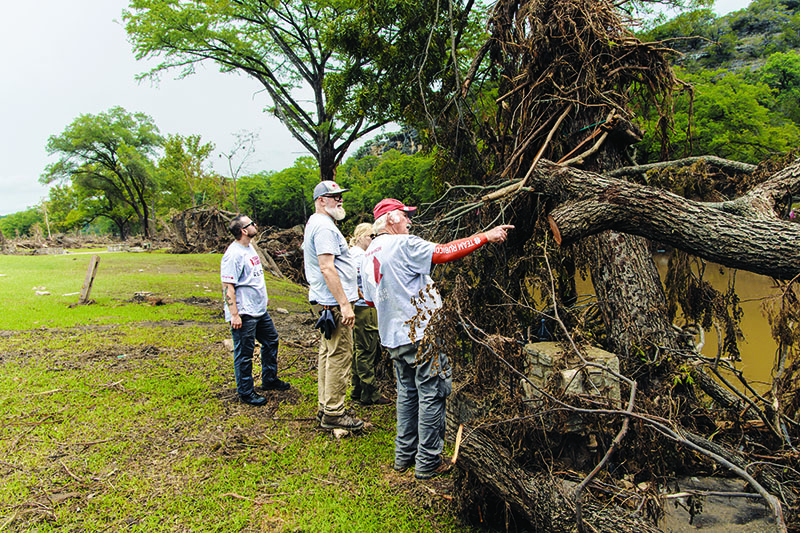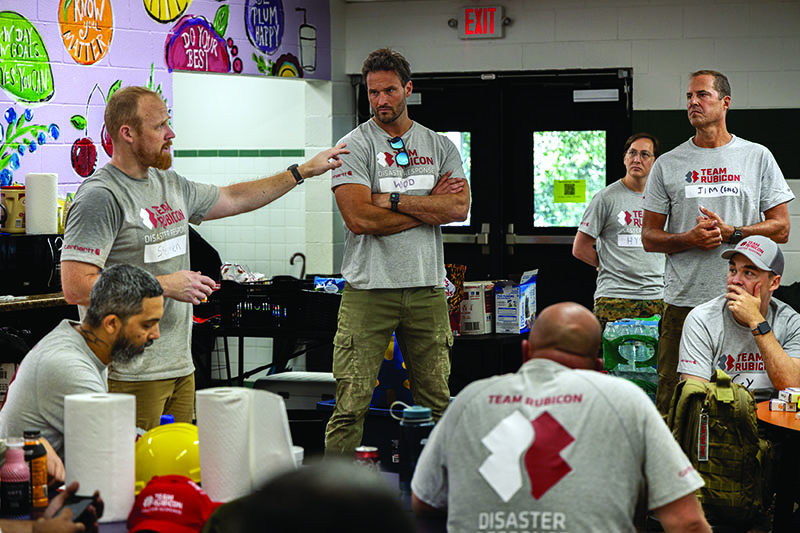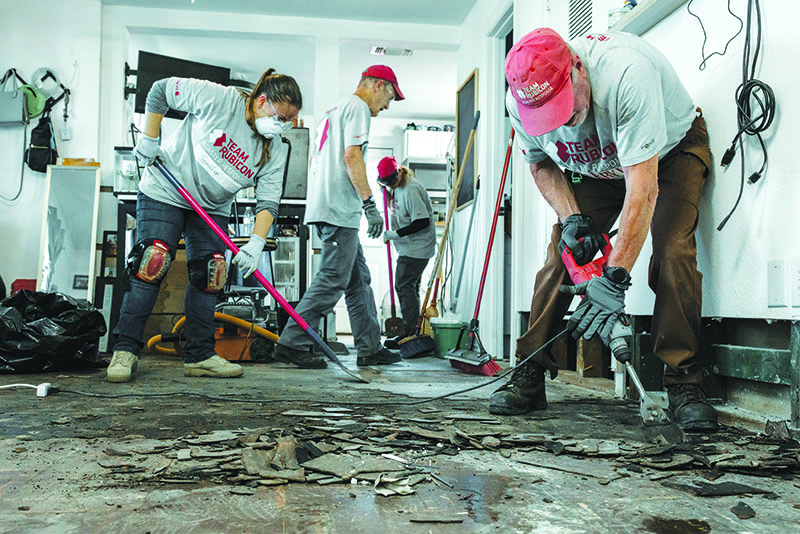Team Rubicon Answers the Call After the Texas Floods
By: LtCol Joel Searls, USMCRPosted on September 15, 2025
Team Rubicon has made a name for itself by leading from the front and being on the ground in some of the world’s largest and most significant catastrophes.
Most recently, the humanitarian organization was in Texas, supporting the relief efforts from the floods that devastated the state’s south-central region. They arrived in Kerr and Tom Green counties less than a week after the tragic floods on July 4; by July 10, Team Rubicon volunteers, known as Greyshirts, were deployed to remove debris blocking homes and provide muck-out services for the survivors.
“Our Greyshirts stepped in pretty early, and we were initially helping with the volunteer coordination,” said Jeff Byard, Marine Corps veteran and senior vice president of operations. “You can see the best of humanity and the worst of humanity in a disaster. … [There was] a lot of outpouring from all over Texas and beyond. There was such a volume of spontaneous volunteers that it made our workload a little lighter, which was good.”

Team Rubicon had 30-man operations running in Kerr County, where Camp Mystic and the bulk of fatalities occurred. Many of the homes were destroyed, and a lot of the area was actively conduct-ing search and rescue, said Byard. Vol-unteers conducted a traditional muck out by removing drywall, flooring and everything down to the studs in order to eliminate mold growth.
“Everyone that you talked to either had a direct fatality or they were one person removed,” Byard said. “The emotion was really thick. It was a heavy one for many of our first-time Greyshirts to walk into.”

Much of the firm’s top leadership was on-site to lead and support the operations. Jim Brooks, the new CEO—a former Navy SEAL and CIA officer—exper-ienced the devastation firsthand during his fourth morning on the job in Hunt, Texas.
“We’re driving down here in a three-vehicle convoy with our strike team, and you just begin to see the flood zone, and the debris far and wide across a very large river valley,” Brooks said. “And you see toilet seats 25 feet up in a tree hanging from branches. Immediately, you just feel how chaotic, how scary, it was. What that disaster must have been like as it was unfolding. A bunch of families were disrupted here, and you go in and you see their lives; their homes that were sitting here along what was normally a flowing, simple, peaceful river, and you see that they were immediately destroyed.”
Brooks was on-site with Team Rubicon co-founder Jake Wood, a Marine Corps veteran who is now serving as the organization’s executive chairman of the board. Wood believes that Brooks has the moxie to lead the organization in a future filled with larger, impactful weather events.

“I’m excited for Jim,” Wood said. “You know, we’re 15 years into this organization, and the one thing that we can’t afford to be is complacent. This organization has been founded with a bias for action. I think we’ve always operated with that urgency … leaning into those moments. I think that’s more important now than ever. Disasters are increasing in frequency and cost. We’re sitting here in the midst of one of the worst flooding disasters in the history of the country, and this is going to continue to happen. So, this organization has to continue to scale, has to continue to innovate. We have to continue to expand the capabilities that we can bring into communities, the types of missions that we can meet in the future. Jim Brooks brings this incredible ground as an executive who has operated at scale within large, complex enterprises. He has demonstrated the ability to innovate, and I think he’s just going to shepherd us into this next version of Team Rubicon, which is going to be bigger and more badass.”

Team Rubicon started in 2010 in re-sponse to the 7.0 earthquake that dev-astated Haiti. Wood saw a critical need for help and responded with a proactive team of eight to Port-au-Prince three days later. His small team provided care and support for thousands of survivors and changed the world for humanitarian aid. They trailblazed beyond the normal world of disaster response. The name for Team Rubicon comes from the boldness of Julius Caesar as he crossed the Rubicon River in Italy, passing the point of no return.
Team Rubicon has pressed forward to lead from the front for hundreds of operations, including global crises. They have responded to support relief for numerous hurricanes, snowstorms, small tornadoes and flooding. Their board of advisors has included many high-profile leaders such as General David Petraeus, General Stanley McChrystal, General James T. Conway, Andy Bessette, Jeff Dailey and Jeff Smith. The team is now over 180,000-plus strong.
From Desert Storm to Team Rubicon
Team Rubicon Senior Vice President of Operations Jeff Byard joined the Marine Corps in the delayed entry program at 17 years old and was in boot camp the Monday after graduating from high school, a memorable experience given what was going on at the time.
“We were awakened in mid-August by a drill instructor and told Iraq had invaded Kuwait,” Byard said. “ ‘All the 0300s step forward,’ said the DI. Half of the platoon stepped forward. The DI told them, ‘You’re all going to die in a chemical gas attack. Get back in the rack.’ ”
Byard said he was shocked, adding that he had convinced his mom to sign for him to enlist, assuring her that he would be fine.
But the situation had now changed for Byard, and he deployed for Desert Storm. After he returned, he was put on a Marine Expeditionary Unit to the Mediterranean and was meritoriously promoted on ship. For his last year and a half, he was stationed in Parris Island, S.C., and was the basic weapons instructor for all of the infantry weapons.
At the end of his initial four-year enlistment, he wanted to “stay in, move from infantry to light armored infantry, [but] they had no more boat spaces,” so he decided to get out and attend college.
His initial involvement with Team Rubicon was as a FEMA appointee; he joined the nonprofit permanently in February of 2020 after having dinner with fellow Marine Team Rubicon executive David Burke.
“I saw an opportunity with a lot lined up,” Byard said. “The mission is awesome: help people.”
The organization’s strong culture resonated with him, as did the Team Rubicon Marine Corps roots. He said it gave him “the ability to still do what [he loves] doing … the field-level disaster response. It is the chaos and teamwork.”
Byard said he had a moment of reflection during Hurricane Laura in 2020, while working in the heat of southern Louisiana. His team was placing a blue tarp on the roof, and he stood there, thinking.
“I got emotional as it dawned on me, over my career, I probably ordered a million blue tarps through my work with the state of Alabama,” Byard said. “It dawned on me that I had never put a blue tarp on a roof. It was my first time doing that during a disaster. It brought a sense of personal satisfaction and told me this is where I needed to be.”
His purposeful experiences continued with Team Rubicon. One of his learning points was going from the government to a “for impact” organization.
“When you move into providing impact, you don’t manage volunteers,” he said. “You lead and inspire volunteers. Any leader needs to have the adaptability gene. In our business, whether government or for impact, people look at emergency management, disaster response or humanitarian work. It’s all people’s work. You’re helping people that have been devastated. It is a chaotic environment. If you’re a people person, that’s a constant improvise, overcome and adapt. Squarely rooted in the Marine Corps.”
Byard loved his time in the Corps, meeting lifelong friends from 2nd Battalion, 4th Marines, whom he still talks to today. The Corps continues to influence his leadership style and success, and he bases his foundational approach on his Corps leadership experiences.
“Operationally, from the Marine Corps, I view our operations as getting Greyshirts to the need. Then get out of there. Don’t be the 3,000-mile screwdriver.”
It’s basic Marine Corps small unit leadership, he said, empowering his people to lead and do the right thing.
“Our job is resources, give them the tools, get the Greyshirts to the need and they will figure out how to overcome and adapt. Our job is a resource provider.”
Team Rubicon has developed a quick reaction force. If a storm hits and if they have the right trained Greyshirts with equipment, they don’t necessarily go through their normal planning process, said Byard. “Speed to need, and … we need to be there when the need is there.” Byard hopes to have a Greyshirt leader in every county and parish in the country.
LtCol Joel Searls, USMCR
To support Team Rubicon in their disaster relief efforts, visit https://team
rubiconusa.org/
Featured Image (Top): Team Rubicon Greyshirts at a flood zone while responding to the Texas Hill Country floods. (Photo courtesy of Team Rubicon)
Author’s bio: LtCol Joel Searls, USMCR, is a journalist, writer and creative who serves in COMMSTRAT for the Marine Corps Reserve. He has completed the Writer’s Guild Foundation Veterans Writing Project, is a produced playwright, a commissioned screenwriter and an entertainment consultant. His most recent feature film-producing project is “Running with the Devil,” and his most recent TV series producing project is “Top Combat Pilot.” He is a graduate of The Ohio State University.




